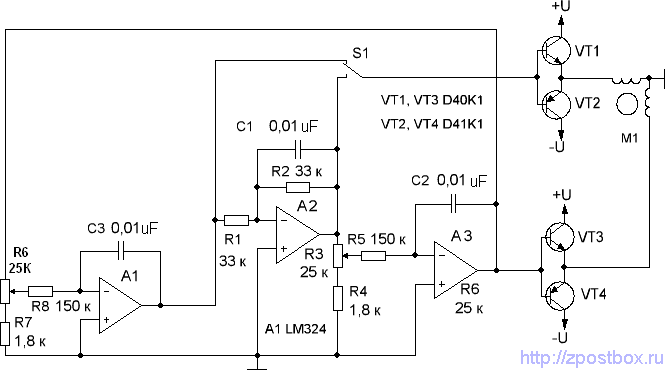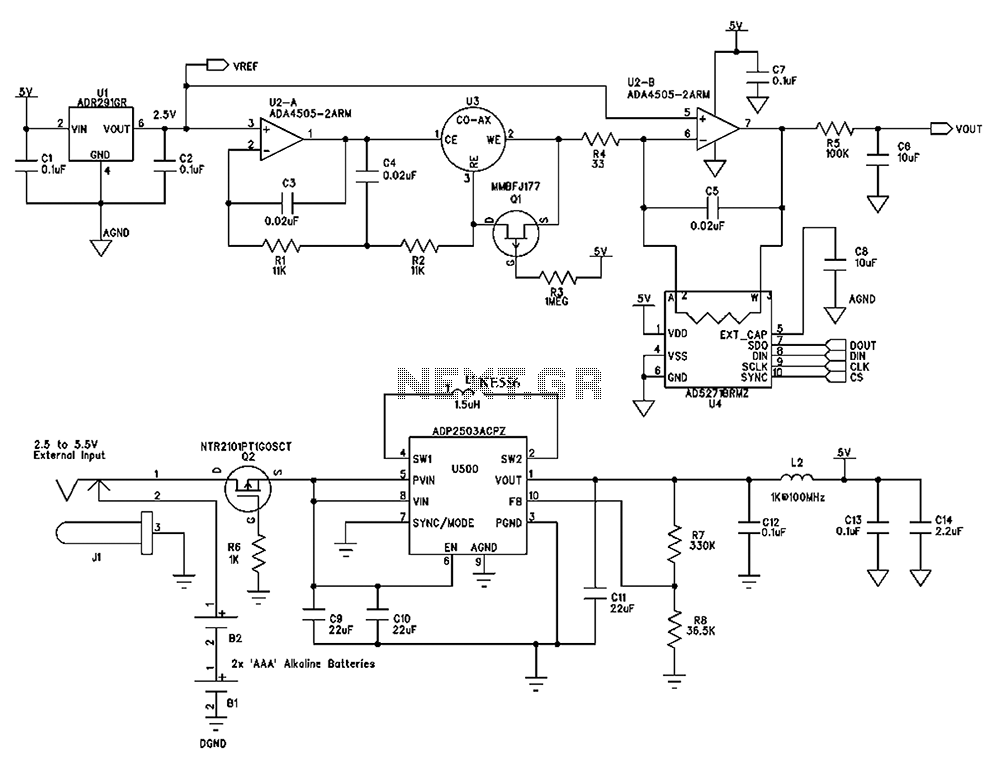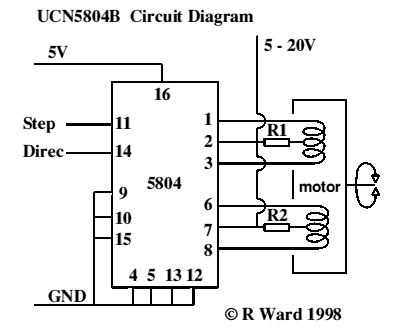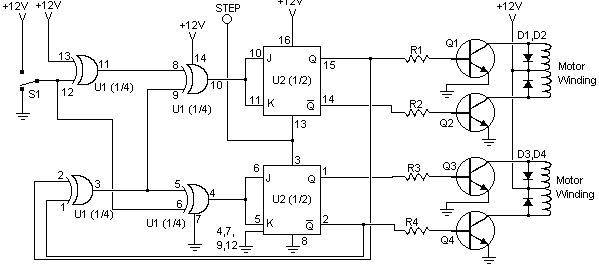
Motor Turn Stall Detector
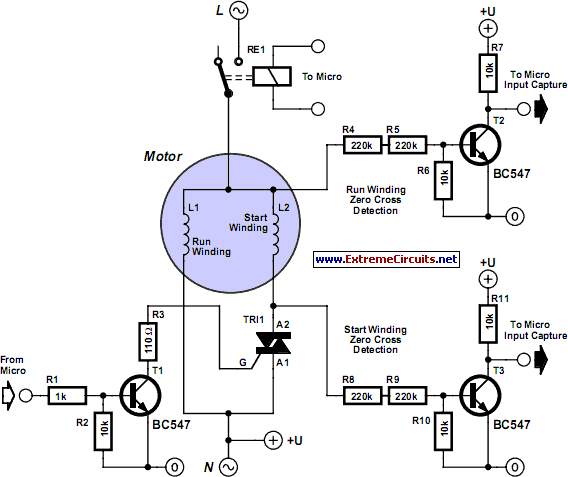
In single-phase AC induction motors, commonly found in refrigerators and washing machines, a start winding is utilized during the initial starting phase. Once the motor reaches a specific speed, this winding is deactivated. The start winding operates slightly out of phase with the run winding. The motor begins to rotate only when the current through the start winding is out of phase with that of the run winding. This phase difference is typically achieved by placing a capacitor of several microfarads in series with the start winding. When the motor attains a minimum speed, a centrifugal switch disables the start winding. The circuit diagram does not illustrate a centrifugal switch; instead, it incorporates a triac that activates during the starting phase. For simplicity, the series capacitor is omitted from the diagram. Once the motor is running, it will continue to operate as long as it is not overloaded. If the motor encounters excessive load, it is likely to stall. A significant current flows in this situation, as the motor ceases to generate back EMF, with the current limited solely by the winding resistance. This condition can lead to overheating and permanent damage over time. Consequently, it is crucial to implement a method to detect when the motor is running, which is relatively straightforward. When the motor is in motion and the start winding is inactive, rotation induces a voltage in the start winding. This induced voltage will be out of phase since the winding is positioned differently compared to the run winding. When the motor stops, this induced voltage aligns with the mains voltage. Relevant waveforms are depicted in the accompanying graph. Additional information can be found in the application note AN2149 published by Motorola, available for download from their website. It is important to note that the circuit presented is only partially complete and cannot be directly implemented. Caution is advised, as mains voltages can be lethal when connected.
In single-phase AC induction motors, the operation of the start winding is essential for initiating rotation. The start winding is designed to create a phase shift that allows the motor to overcome inertia and begin turning. The capacitor used in series with the start winding is crucial for establishing this phase difference, which typically ranges from 5 to 20 microfarads, depending on the motor's design specifications.
The triac employed in place of the centrifugal switch serves to electronically control the start winding, allowing for more precise activation and deactivation based on the motor's operational state. The triac is triggered by a control circuit that monitors the motor's speed, ensuring that the start winding is only engaged during the initial start-up phase and is turned off once the motor reaches a predetermined speed.
The detection of motor rotation is accomplished by sensing the induced voltage in the start winding. This voltage can be monitored using a microcontroller or a simple comparator circuit, which compares the phase of the induced voltage with the mains voltage. When the motor is running, the phase difference will indicate that the start winding can be safely deactivated. Conversely, when the motor stops, the phase alignment of the induced voltage with the mains voltage signals that the start winding may need to be re-engaged to restart the motor.
Protection mechanisms such as current sensing resistors or thermal overload switches can be integrated into the circuit to prevent overheating and potential damage to the motor. These components can be used to cut off power to the motor in the event of a stall condition, ensuring safe operation and longevity of the motor.
Overall, careful consideration of the circuit design, including the integration of the triac, capacitor, and protective measures, is essential for the reliable operation of single-phase AC induction motors in household appliances. Proper schematic representation and adherence to electrical safety standards are crucial for successful implementation.In single phase AC induction motors, often used in fridges and washing machines, a start winding is used during the starting phase. When the motor has reached a certain speed, this winding is turned off again. The start winding is slightly out of phase to the run winding. The motor will only start turning when the current through this winding is o ut of phase to that of the run winding. The phase difference is normally provided by placing a capacitor of several µF in series with the start winding. When the motor reaches a minimum speed, a centrifugal switch turns off the start winding. The circuit diagram doesn`t show a centrifugal switch; instead it has a triac that is turned on during the staring phase.
For clarity, the series capacitor isn`t shown in the diagram. Once the motor turns it will continue to do so as long as it isn`t loaded too much. When it has to drive too heavy a load it will almost certainly stall. A large current starts to flow (as the motor no longer generates a back EMF), which is limited only by the resistance of the winding. This causes the motor to overheat after a certain time and causes permanent damage. It is therefore important to find a way to detect when the motor turns, which happens to be surprisingly easy.
When the motor is turning and the start winding is not used, the rotation induces a voltage in this winding. This voltage will be out of phase since the winding is in a different position to the run winding. When the motor stops turning this voltage is no longer affected and will be in phase with the mains voltage.
The graph shows some of the relevant waveforms. More information can be found in the application note for the AN2149 made by Motorola, which can be downloaded from their website at We think this contains some useful ideas, but keep in mind that the circuit shown is only partially completed. As it stands, it certainly can`t be put straight to use. We should also draw your attention to the fact that mains voltages can be lethal, so take great care when the mains is connected!
🔗 External reference
In single-phase AC induction motors, the operation of the start winding is essential for initiating rotation. The start winding is designed to create a phase shift that allows the motor to overcome inertia and begin turning. The capacitor used in series with the start winding is crucial for establishing this phase difference, which typically ranges from 5 to 20 microfarads, depending on the motor's design specifications.
The triac employed in place of the centrifugal switch serves to electronically control the start winding, allowing for more precise activation and deactivation based on the motor's operational state. The triac is triggered by a control circuit that monitors the motor's speed, ensuring that the start winding is only engaged during the initial start-up phase and is turned off once the motor reaches a predetermined speed.
The detection of motor rotation is accomplished by sensing the induced voltage in the start winding. This voltage can be monitored using a microcontroller or a simple comparator circuit, which compares the phase of the induced voltage with the mains voltage. When the motor is running, the phase difference will indicate that the start winding can be safely deactivated. Conversely, when the motor stops, the phase alignment of the induced voltage with the mains voltage signals that the start winding may need to be re-engaged to restart the motor.
Protection mechanisms such as current sensing resistors or thermal overload switches can be integrated into the circuit to prevent overheating and potential damage to the motor. These components can be used to cut off power to the motor in the event of a stall condition, ensuring safe operation and longevity of the motor.
Overall, careful consideration of the circuit design, including the integration of the triac, capacitor, and protective measures, is essential for the reliable operation of single-phase AC induction motors in household appliances. Proper schematic representation and adherence to electrical safety standards are crucial for successful implementation.In single phase AC induction motors, often used in fridges and washing machines, a start winding is used during the starting phase. When the motor has reached a certain speed, this winding is turned off again. The start winding is slightly out of phase to the run winding. The motor will only start turning when the current through this winding is o ut of phase to that of the run winding. The phase difference is normally provided by placing a capacitor of several µF in series with the start winding. When the motor reaches a minimum speed, a centrifugal switch turns off the start winding. The circuit diagram doesn`t show a centrifugal switch; instead it has a triac that is turned on during the staring phase.
For clarity, the series capacitor isn`t shown in the diagram. Once the motor turns it will continue to do so as long as it isn`t loaded too much. When it has to drive too heavy a load it will almost certainly stall. A large current starts to flow (as the motor no longer generates a back EMF), which is limited only by the resistance of the winding. This causes the motor to overheat after a certain time and causes permanent damage. It is therefore important to find a way to detect when the motor turns, which happens to be surprisingly easy.
When the motor is turning and the start winding is not used, the rotation induces a voltage in this winding. This voltage will be out of phase since the winding is in a different position to the run winding. When the motor stops turning this voltage is no longer affected and will be in phase with the mains voltage.
The graph shows some of the relevant waveforms. More information can be found in the application note for the AN2149 made by Motorola, which can be downloaded from their website at We think this contains some useful ideas, but keep in mind that the circuit shown is only partially completed. As it stands, it certainly can`t be put straight to use. We should also draw your attention to the fact that mains voltages can be lethal, so take great care when the mains is connected!
🔗 External reference
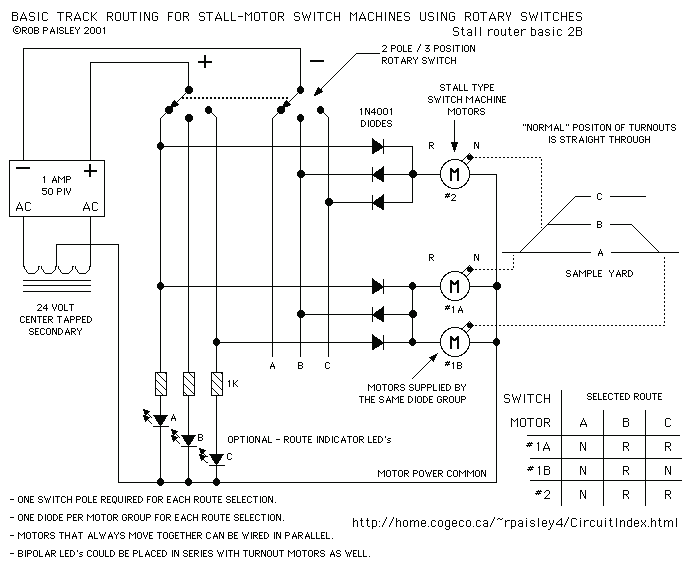
%2Busing%2Bop%2Bamp%2B741%2Bic%2B.png)
